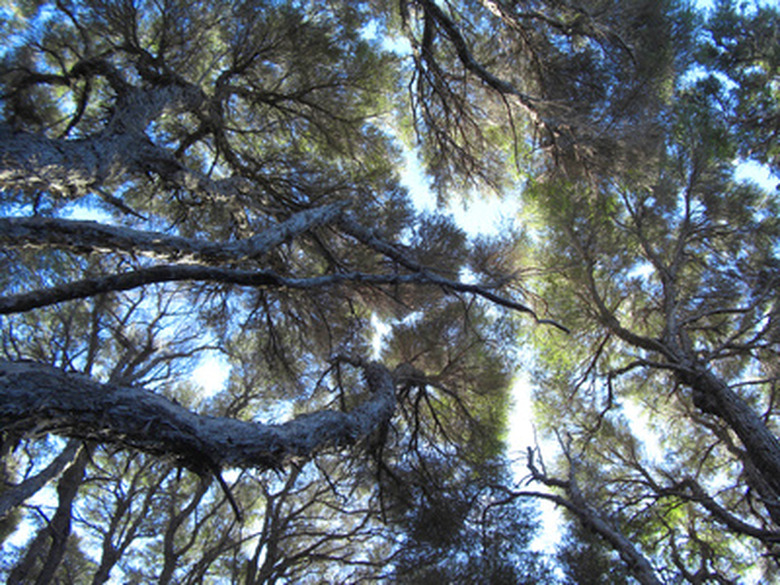Definition Of A Canopy Tree
Canopy trees, also called shade trees, are huge trees with thick canopies or foliage coverings. The canopy trees of a rainforest make up the highest layer of leaf coverings and consist of the largest and oldest trees, notes the University of Minnesota. In addition to growing in rainforests, canopy trees can be found in many regions where they offer shade and other benefits. Some well-known canopy trees include oaks, birches, crepe myrtles, elms, ashes and others.
Identification
Canopy tree foliage is smooth and oval, ending in a point. These trees are closely spaced, forming a thick roof over vegetation in lower levels. However, this roof isn't solid, but somewhat permeable, according to the Smithsonian Tropical Research Institute. Canopy branches and leaves both absorb and deflect sunlight that pours downward, allowing limited sunlight through the foliage. As a result, lower portions of a forest appear greenish and dim. Dense and enclosing greenery also helps darken the canopy's insides.
- Canopy trees, also called shade trees, are huge trees with thick canopies or foliage coverings.
Size
According to Mongabay.com, some canopy species grow to more than 210 feet tall. The world's tallest tree, located in northern California, is the coast redwood. This colossal canopy tree measures 379.3 feet, according to the University of Washington. In a typical forest, there could be 150 to 250 canopy trees per hectare, which is 2.47 acres, notes the University of Minnesota.
Time Frame
In the Great Lakes region of the United State, canopy trees can live from 50 to 150 years or more. Older hardwood forest trees can have a lifespan of 200 to 400 years, notes the University of Minnesota. In other regions of America, canopies live even longer, such as those of the Pacific Northwest. Besides being the world's tallest tree, California's coast redwood can survive as long as 2,000 years, according to EcoWorld.com.
- According to Mongabay.com, some canopy species grow to more than 210 feet tall.
- Older hardwood forest trees can have a lifespan of 200 to 400 years, notes the University of Minnesota.
Benefits
Canopy leaves are a power source for a forest because they convert sunlight into energy through the process of photosynthesis. Because canopy trees have a high rate of photosynthesis, plants under canopy trees produce more seeds, fruits, leaves and flowers. This results in a wide range of animal life. Canopy trees help regulate both regional and global climate, as they're the main site for the interchange of heat, atmosphere gases and water vapor. They also protect understory vegetation from intense and harsh sunrays, heavy rainfall and drying winds, points out the Mongabay web site.
Geography
Canopy trees grow in Central and South American rainforests. The Patagonia Cypress, one of the world's most majestic trees, grows on the western slopes of Chile's Andes Mountains.
- Canopy leaves are a power source for a forest because they convert sunlight into energy through the process of photosynthesis.
- Because canopy trees have a high rate of photosynthesis, plants under canopy trees produce more seeds, fruits, leaves and flowers.
North America's Pacific Northwest is home to some of the highest canopies grown on earth. Douglas firs are found growing on hillsides of the Santa Cruz Mountains, topping 200 feet or more, notes EcoWorld.com.
Canopy Examples
The Jamaican dogwood is a fast-growing canopy tree with showy white or lavender flowers. It's highly drought tolerant.
Gumbo limbos grow quickly and reach up to 40 to 60 feet. It's used for shade and can grow well in parking lots, roadsides and in yards that don't have overhead power lines. The tree has attractive bark and is exceptionally salt and drought-tolerant, notes the University of Florida.
- North America's Pacific Northwest is home to some of the highest canopies grown on earth.
- Douglas firs are found growing on hillsides of the Santa Cruz Mountains, topping 200 feet or more, notes EcoWorld.com.
Mahoganies can grow to 40 feet high. These canopy trees can be used to frame landscapes. They have a rounded, brown symmetrical crown and don't cast heavy shade.
